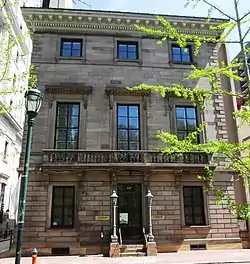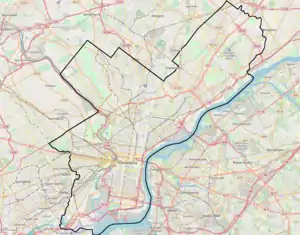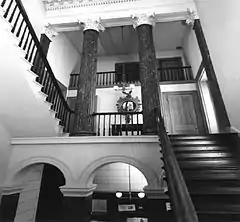 The Athenaeum of Philadelphia in 2013 | |
| Location | 219 S. 6th St. Philadelphia, Pennsylvania, U.S. |
|---|---|
| Coordinates | 39°56′49″N 75°09′03″W / 39.946871°N 75.150956°W |
| Architect | John Notman |
| Public transit access | |
   | |
| Built | 1845 |
| Architectural style | Italianate |
| NRHP reference No. | 72001144 |
| Significant dates | |
| Added to NRHP | February 1, 1972[1] |
| Designated NHL | December 8, 1976[2] |
The Athenaeum of Philadelphia, located at 219 S. 6th Street between St. James Place and Locust Street in the Society Hill neighborhood of Philadelphia, Pennsylvania, is a special collections library and museum founded in 1814 to collect materials "connected with the history and antiquities of America, and the useful arts, and generally to disseminate useful knowledge" for public benefit.[3] The Athenaeum's collections include architecture and interior design history, particularly for the period 1800 to 1945. The institution focuses on the history of American architecture and building technology, and houses architectural archives of 180,000 drawings, over 350,000 photographs, and manuscript holdings of about 1,000 American architects.[3]
Since 1950 the Athenaeum has sponsored the annual Athenaeum Literary Award for works of fiction and non-fiction.
Historic building

The building was designed in 1845 by architect John Notman in the Italianate style, and was one of the first buildings in the city to be built of brownstone,[3] although it was originally planned to be faced in marble. Brownstone was used because it was cheaper.[4] Notman's design was influenced by the work of the English architect Charles Barry.[4]
The building was declared a National Historic Landmark in 1976, as one of the nation's first examples of a building with a palazzo-style facade, and for its historic importance as an educational institution.[2][5] It is presently a museum furnished with American fine and decorative arts from the first half of the 19th century.
On the right of the athenaeum is the house of Richardson Dilworth, the Mayor of Philadelphia from 1956 to 1962.
Integration with Penn Libraries
In 2019, the Athenaeum of Philadelphia entered into an agreement with the libraries of the University of Pennsylvania to integrate their two collections, giving borrowing privilege to each other's patrons and making the Athenaeum's collection, which is focused on architecture, the built environment, and the decorative arts, searchable in Penn's online catalog. [6]
Athenaeum Literary Award
The Athenaeum Literary Award is a literary award presented by Athenaeum of Philadelphia since 1950. It is awarded to authors who are "bona fide residents of Philadelphia or Pennsylvania living within a radius of 30 miles of City Hall".[7] Eligible works are of general fiction or non-fiction; technical, scientific, and juvenile books are not included.[7] The award was established in 1950 by Charles Wharton Stork (1881–1971), who was a board member of the Athenaeum from 1919 until 1968.[7]
- Recipients
Source: Athenaeum Literary Award previous winners (1949–present)[8]
- 1949
- John L. Lamonte, The World of the Middle Ages
- 1950
- Henry N. Paul, The Royal Play of Macbeth
- 1951
- Arthur Hobson Quinn, 'The Literature of the American People
- 1952
- Nicholas B. Wainwright, A Philadelphia Story
- 1953
- Lawrence Henry Gipson, The Great War for the Empire 1760-1763, vol. 8, The Culmination, 1760-1763
- 1954
- 1955
- Conyers Read, Mr. Secretary and Queen Elizabeth
- 1956
- Livingston Biddle, Jr., The Village Beyond
- Samuel Noah Kramer, From the Tablets of Summer
- 1957
- Catherine Drinker Bowen, The Lion and the Throne
- Bettina Linn, A Letter to Elizabeth
- 1958
- Loren Eisley,[sic] Darwin's Century
- Lyon Sprague DeCamp,[sic] An Elephant for Aristotle
- 1959
- 1960
- Edwin Wolf II (with John F. Fleming), Rosenbach: a biography
- David Taylor, Storm the Last Rampart
- 1961
- Roy F. Nichols, The Stakes of Power, 1845-1877
- Lauren R. Stevens, The Double Axe
- 1962
- Curtis Bok, Maria
- Carleton S. Coon, The Origin of Races
- Richard S. Dunn, Puritans and Yankees
- 1963
- Daniel Hoffman, The City of Satisfactions
- Samuel Noah Kramer, The Sumerians
- 1964
- Kristin Hunter, God Bless the Child
- Elizabeth Gray Vining, Take Heed of Loving Me
- Dorothy Shipley White, Seeds of Discord
- 1965
- Laurence Davis Lafore, The Long Fuse
- 1966
- Edward S. Gifford, Jr., Father Against the Devil
- 1967
- Daniel P.Mannix, The Fox and the Hound
- Edmund N. Bacon, Design of Cities
- 1968
- Ernest Penney Earnest, Expatriates and Patriots
- Robert C. Smith, The Art of Portugal
- 1969
- Henry Clarence Pitz, The Brandywine Tradition
- Chaim Potok, The Promise
- 1970
- No award
- 1971
- Loren Eiseley, The Night Country
- 1972
- Jerre Mangione, The Dream and the Deal
- 1973
- John Maas, The Glorious Enterprise
- 1974
- 1975
- Martin P. Snyder, City of Independence
- 1976
- No award
- 1977
- Seymour Adelman, The Moving Pageant
- John Francis Marion, Famous and Curious Cemeteries
- Barbara Rex, I Want to Be in Love Again
- 1978
- Anthony F.C. Wallace, Rockdale
- Peggy Anderson, Nurse
- Elizabeth Gray Vining, Being Seventy
- Jan V. Westcott, A Woman of Quality
- 1979
- E. Digby Baltzell, Puritan Boston and Quaker Philadelphia
- Richard J. Boyle, John Twachtman
- Dorothy Shipley White, Black Africa and De Gaulle
- 1980
- Arthur R.G. Solmssen, A Princess in Berlin
- Lois G. Forer, Criminals and Victims
- James C. Humes, Churchill: Speaker of the Century
- 1981
- David Bradley, The Chaneysville Incident
- Daniel Hoffman, Brotherly Love
- John A. Lukacs, Philadelphia, Patricians & Philistines, 1900-1950
- Edgar P. Richardson, Charles Willson Peale and His World
- Russell F. Weigley, Eisenhower's Lieutenants
- 1982
- Susan Gray Detweiler, George Washington's Chinaware
- Jean Seder, Voices of Kensington
- Desmond Ryan, Deadlines
- Seymour Shubin, The Captain
- David R. Slavitt, Ringer
- 1983
- Gerald Carson, The Dentist and the Empress
- Helen H. Gemmill, E.L., the Bread Box Papers
- 1984
- Roland M. Frye, The Renaissance Hamlet
- Jean Gordon Lee, Philadelphians and the China Trade, 1784-1844
- Philip Chadwick Foster Smith, The Empress of China
- 1985
- Ralph Keyes, Chancing It
- Thomas Maeder, Crime and Madness
- Carroll Smith-Rosenberg, Disorderly Conduct
- 1986
- David Eisenhower, Eisenhower: At War, 1943-1945
- Julie Nixon Eisenhower, Pat Nixon
- Michael Malone, Handling Sin
- Barry Schwartz, The Battle for Human Nature
- 1987
- No award
- 1988
- Marilyn Gaull, English Romanticism
- Barbara Holland, The Name of the Cat
- John Allen Paulos, Innumeracy
- 1989
- Coral Lansbury, The Grotto
- Emily W. Sunstein, Mary Shelley
- James Snyder, Medieval Art
- 1990
- Matthews Masayuki Hamabata, Crested Kimono
- Camille Paglia, Sexual Personae
- Paul Halpern, Time Journeys
- Ora Mendels, A Taste for Treason
- 1991
- Art Carey, The United States of Incompetence
- Elizabeth Johns, American Genre Painting
- Roger Lane, William Dorsey's Philadelphia and Ours
- 1992
- Arthur Power Dudden, The America Pacific
- 1993
- Seymour I. Toll, A Judge Uncommon
- Susan Q. Stranahan, Susquehanna, River of Dreams
- 1994
- Paul Fussell, The Anti-Egotist
- Steve Lopez, Third and Indiana
- Barry Schwartz, The Costs of Living
- 1995
- Thomas Childers, Wings of Morning
- Witold Rybczynski, City Life
- Susan Stewart, The Forest
- 1996
- Peter Conn, Pearl S. Buck: A Cultural Biography
- Diane McKinney-Whetstone, Tumbling
- 1997
- A.C. Elias, Jr., Memoirs of Laetitia Pilkington
- Kathleen A. Foster and Kenneth Finkel, Captain Watson's Travels in America
- David P. Silverman, Ancient Egypt
- Mary Walton, Car
- 1998
- James J. O'Donnell, Avatars of the Word
- Leonard Warren, Joseph Leidy: The Last Man Who Knew Everything
- 1999
- J. Welles Henderson & Rodney P. Carlisle, Jack Tar: A Sailor's Life, 1750–1910
- Witold Rybczynski, A Clearing In The Distance
- Jonathan Weiner, Time, Love, Memory
- 2000
- Susan Sidlauskas, Body, Place, and Self in Nineteenth-Century Painting
- Patricia Tyson Stroud, The Emperor of Nature; Charles-Lucien Bonaparte and His World
- George E. Thomas, William L. Price; Arts and Crafts to Modern Design
- Ben Yagoda, About Town; The New Yorker and the World It Made
- 2001
- No award.
- 2002
- Jane Golden, Robin Rice & Monica Yant Kinney, Philadelphia Murals and the Stories They Tell
- Charlene Mires, Independence Hall in American Memory
- 2003
- Jack Repcheck, The Man Who Found Time
- 2004
- Roger W. Moss, Historic Sacred Places of Philadelphia
- 2005
- Kermit Roosevelt, In the Shadow of the Law
- 2006
- David Traxel, Crusader Nation: The United States in Peace and the Great War, 1898–1920
- 2007
- Jon Clinch, Finn: A Novel
- 2008
- Walter A. McDougall, Throes of Democracy: The American Civil War Era, 1829–1877
- 2009
- Richard Beeman, Plain, Honest Men: The Making of The American Constitution
- 2010
- Robin Black, If I Loved You, I Would Tell You This: Stories
- Stephen Fried, Appetite For America: How Visionary Businessman Fred Harvey Built a Railroad Hospitality Empire that Civilized the West
- 2011
- No award.
- 2012
- Liz Moore, Heft: A Novel
- Steven Ujifusa, A Man and His Ship: America’s Greatest Naval Architect and His Quest to Build the S. S. United States
- Robert McCracken Peck and Patricia Tyson Stroud, A Glorious Enterprise: The Academy of Natural Sciences of Philadelphia and the Making of American Science
- 2013
- Adrian Raine, The Anatomy of Violence: The Biological Roots of Crime
- George H. Marcus and William Whitaker, The Houses of Louis Kahn
- 2014
- Jessica Choppin Roney, Governed By A Spirit of Opposition
- 2015
- David Grazian, American Zoo: A Sociological Safari
- Barbara Miller Lane, Houses for a New World: Builders and Buyers in American Suburbs
- 2016
- Gino Segre and Bettina Hoerlin, The Pope of Physics
- Judith E. Stein, Eye of the Sixties
- 2017
- Erica Armstrong Dunbar, "Never Caught: the Washingtons' Relentless Pursuit of Their Runaway Slave Ona Judge"
- Carol Eaton Soltis, "The Art of the Peales in the Philadelphia Museum of Art"
- 2018
- Madeline Miller, Circe
- Patrick Spero, Frontier Rebels: the Fight for Independence in the American West, 1765-1776
- 2019
- Edward Posnett, Strange Harvests
- Witold Rybczynski, Charleston Fancy
- 2020
- Michele Harper, The Beauty in Breaking
- Lynn Miller and Therese Dolan, Salut! France Meets Philadelphia
- 2021
- Quiara Alegria Hudes, My Broken Language
- Miles Orvell, Empire of Ruins
- 2022
- Will Bunch, After the Ivory Tower Falls
- John Lobell, The Philadelphia School and the Future of Architecture
- Laura Wolf-Powers, University City: History, Race, and Community in the Era of the Innovation District
See also
References
Notes
- ↑ "National Register Information System". National Register of Historic Places. National Park Service. January 23, 2007.
- 1 2 "Athenaeum". National Historic Landmark summary listing. National Park Service. Retrieved February 16, 2008.
- 1 2 3 "Mission and History" Archived 2013-01-07 at the Wayback Machine on the Athenaeum of Philadelphia website
- 1 2 Gallery, John Andrew, ed. (2004), Philadelphia Architecture: A Guide to the City (2nd ed.), Philadelphia: Foundation for Architecture, ISBN 0962290815, p.51
- ↑ Carolyn Pitts (July 29, 1976). "National Register of Historic Places Inventory-Nomination: the Athenaeum of Philadelphia" (pdf). National Park Service. and Accompanying 6 photos, exterior and interior, from 1951, 1971, and undated (32 KB)
- ↑ Salisbury, Stephan (February 14, 2019). "Penn Libraries and venerable Philadelphia Athenaeum form bookish alliance". The Philadelphia Inquirer. Retrieved January 3, 2024.
- 1 2 3 Athenaeum Literary Award Archived 2011-05-22 at the Wayback Machine, official website.
- ↑ "Athenaeum Literary Award previous winners (1949-present)". Athenaeum of Philadelphia. Archived from the original on May 22, 2011. Retrieved December 25, 2017.
External links
- Official website
- Athenaeum Literary Award Archived 2011-05-22 at the Wayback Machine, official website.
- Historic American Buildings Survey (HABS) No. PA-1389, "Philadelphia Athenaeum"

